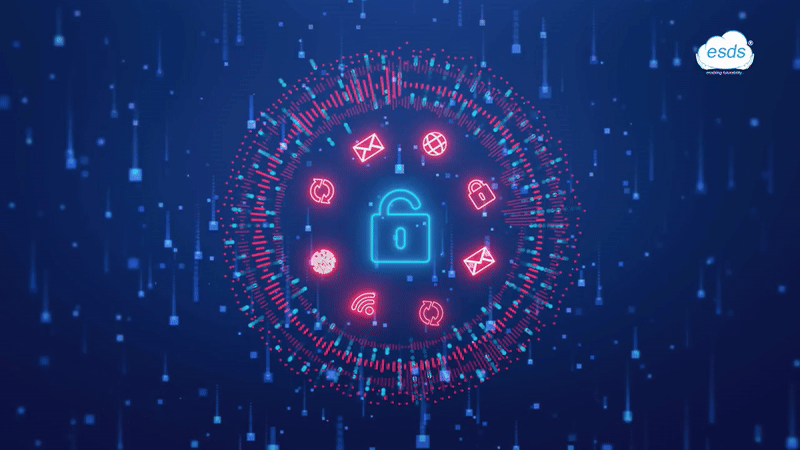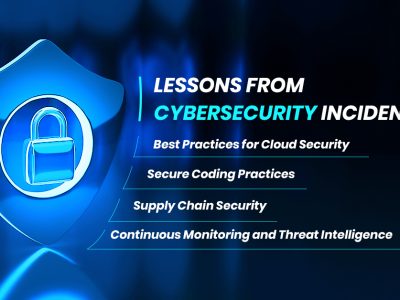What Have We Learned from The Recent Cybersecurity Incidents?

The current technological era is accelerating at a rate never seen before, allowing modern businesses to undertake ambitious digital transformation initiatives. However, the swift digitization of business procedures is also giving malevolent actors fresh ways to conduct cyberattacks. Simultaneously, the surge in the generation of data and analytics results in an increasing number of data breaches. These are a few of the causes of the alarming rise in data loss and cybersecurity incidents.
With every breach, businesses and individuals risk severe repercussions, such as monetary losses, harm to their reputations, and compromising of personal data. Plus, the growing regularity and sophistication of these events emphasize the urgency to apply the lessons discovered from previous breaches in order to defend against such assaults. As a result, it is becoming increasingly important for businesses to examine the important lessons that can be drawn from the most recent high-profile data breaches and cybersecurity incidents. Analyzing recent data breaches is a great way to improve current cybersecurity protocols and policies.
Capital One Breach
A significant data breach at Capital One in 2019 resulted in the exposure of over 100 million customers’ personal data. This incident made clear the dangers of cloud computing and the necessity of more robust security measures in cloud systems. The following lessons can be learned from the examination of the effects and remedies of the Capital One data breach:
Lesson 1: Best Practices for Cloud Security
To safeguard sensitive data stored in the cloud, businesses must put in place the right security policies, such as robust access controls, encryption, and ongoing monitoring. It’s equally imperative to do regular security updates and assessments.
Lesson 2: Secure Coding Practices
An improperly configured web application firewall triggered the Capital One breach. Implementing secure coding practices as well as regular audits of application security can enable the implementation of data breach prevention strategies and mitigate similar vulnerabilities.

SolarWinds Supply Chain Attack
2020 saw the surfacing of the SolarWinds supply chain attack, which illustrated the sophisticated threat actors’ expanding strategies for indirectly infiltrating enterprises. It highlighted the significance of proactive threat intelligence and monitoring and revealed a serious weakness in supply chain security. Here are some of the main lessons learnt from this incident:
Lesson 3: Supply Chain Security
To guarantee proper protection of crucial systems and data, businesses must carefully screen outside providers, examine their security procedures, and carry out frequent security audits.
Lesson 4: Continuous Monitoring and Threat Intelligence
To reduce the possible harm brought about by a supply chain attack, businesses should put in place a strong system for exchanging threat intelligence, continuous monitoring, and early identification of aberrant activity.
WannaCry Ransomware Attack
The WannaCry ransomware attack in 2017 affected numerous businesses by affecting over 200,000 computers in over 150 countries. This incident made clear the value of strong cybersecurity procedures and the necessity for taking preventative action to lessen the consequences. Among the principal lessons learned are:
Lesson 5: Regular Patch Management
WannaCry exploited of a flaw in obsolete Microsoft Windows systems. Thus, one of the fallout from this cybersecurity disaster is that companies need to update and patch all of their software on a regular basis to stop hackers from taking advantage of vulnerabilities that are known to exist. They can use automated methods for secure software development, such as DevSecOps, in this direction.
Lesson 6: Awareness and Training for Employees
Email phishing was a major factor in the WannaCry outbreak. Preventing similar attacks requires training staff members on how to identify and report questionable emails and attachments. With the development of generative AI technologies like as ChatGPT, adversaries may now easily generate a large number of phishing emails that appear authentic. Employee education is therefore more crucial than ever.

The Equifax Breach
2017’s Equifax data leak is among the most well-known in recent memory. This breach exposed approximately 147 million customers’ sensitive personal information, which should serve as a constant reminder that businesses must prioritize the upkeep of strong cybersecurity protections and best practices. This breach can teach us, in particular, the following cybersecurity incident insights and lessons:
Lesson 7: Apply Robust Identity and Access Management (IAM) Controls
Attackers used a known weakness in unpatched software causing the Equifax breach. To avoid unwanted access, businesses should make sure that appropriate access restrictions are in place and that their systems are regularly updated with the most recent security patches. It is imperative to take into account Zero Trust Architectures (ZTA) in the context of cybersecurity, wherein an actor’s credibility is not presumed until it is verified with appropriate credentials.
Lesson 8: End-to-End Encryption and Data Segmentation
Based on the breach, it is possible to reduce the possible impact of a breach by limiting an attacker’s access to or capacity to exfiltrate important data by encrypting sensitive data and segmenting networks. These days, businesses have access to sophisticated encryption methods like homographic encryption, which can be quite helpful in guaranteeing the security and resilience of data.
In Summary
Overall, data breaches and cybersecurity incidents continue to provide serious obstacles for businesses of all kinds. Through the analysis of cybersecurity incident response best practices and case studies pertaining to data breaches, contemporary companies can discern numerous imperative insights that can serve to reinforce their cybersecurity protocols. Risks can be significantly reduced by putting in place robust identity and access management controls, frequent patch management, employee education, secure coding techniques, cloud security measures, supply chain security, and constant monitoring.
It is imperative for businesses to take proactive measures to safeguard their confidential data and uphold the trust of their clients alongside the stakeholders. Modern businesses may develop useful cyber incident mitigation advice, thorough data incident handling guidelines, and efficient cybersecurity incident management procedures by examining examples of data breach incidents and conducting reliable cyber event impact assessments. Similar to that, the documentation of appropriate data breach prevention measures and best-in-class data beach prevention strategies is the best way to define data breach preparedness. This could help businesses stand out in terms of their reputation for data protection and cyber-resilience.
- 6 Ways AI Reinvents the Security Landscape - January 9, 2024
- Top 6 Current Cybersecurity Trends For 2024 - January 9, 2024
- What Have We Learned from The Recent Cybersecurity Incidents? - January 3, 2024
